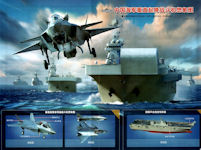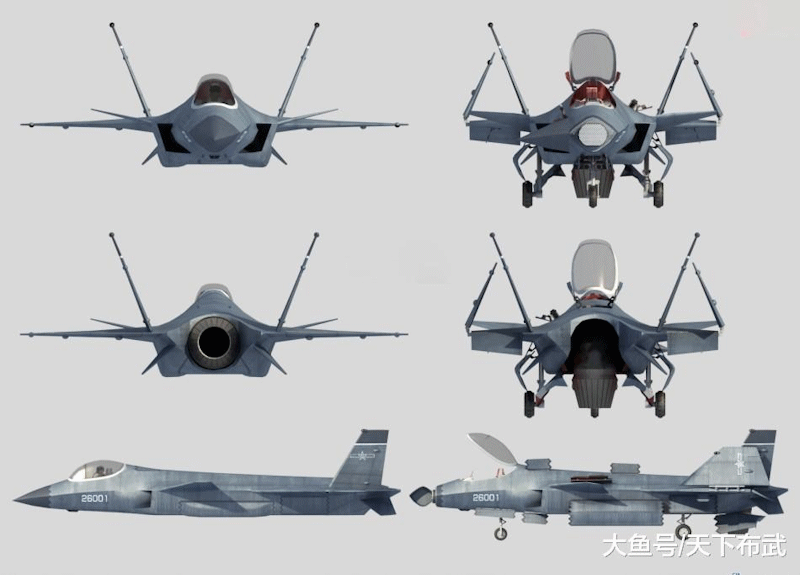.
.
.
.
.
.



.
.
..


J-18 Red Eagle VSTOL (Jianjiji-18 Fighter aircraft 18).J-18 Red Eagle VSTOL.
賀中國空軍J-18/RE.紅鷹垂直起降隱形戰鬥機試飛成功.
China has been rumored since at least 2011 to be working on a STOVL [short take off / vertical landing] aircraft, with the UK/US AV-8 Harrier US F-35B as examples. A STOVL [short take off / vertical landing] aircraft can take off from a short runway and land vertically without a runway. STOVL fighter jets would shine on amphibious assault ships even more than on aircraft carriers. This kind of ship is not designed for a normal fixed-wing fighter jet to take off and land, but a STOVL aircraft can. The Harrier was largelly a response to limited budgets which precluded big-deck carriers, and the F-35B is largely an artifact of the peculiar institution - the US Marine Corps - which requires an aviation capability unlike all others. Chna faces neither of these constraints. Chinas shipbuilding program appears to be unconstrained by financial considerations, and Chinas naval infantry is a feeble shadow of the US Marine Corps. VSTOL aircraft have long been plagued by modest combat capabilites imposed by limited engine performance, and Chinese military aviation generally faces severe constraints due to the paltry performance of deomestic engines.
China is a big country, and has a very energetic and creative aerospace industry that is limited by technology not finances. Surely somewhere in the bowels of Chinese industry there is a team looking at VSTOL aircraft. But after a decade of speculation and artwork, no "F-35B With Chinese Characterisics Under Modern Conditions" has been forthcoming. There is artwork, but no photographs of wind tunnel models, no displays at trade shows, no full scale mock-ups, or any of the other indicators of a real program.
According to some sources the J-18 nomenclature was reportedly the "Snowy Owl" stealthy JSF-type aircraft. Details about the Chinese J-18 project are speculative. Chinese authorities have not formally released informtion on these developments. The "J-18" might simply be the J-15 Chinese copy of the Su-33 that appeared in a naval paintjob around the same time the J-18 rumors surfaced.
Under the Snowy Owl nomenclature, China was said to be secretly developing a triplane-canard-configurated fighter that has a totally different layout than the J-20, CCTV was quoted by Hong Kong-based Sing Tao Daily as reporting. Some Chinese online military experts believe that the Snowy Owl fighter was being developed by the AVIC Shenyang Aircraft Corporation (SIC). Online information regarding the SIC says that it was manufacturing a new type of aircraft whose design uses triplane canard configuration, Chinese netizens reported. The aircraft has a fixed vertical wing, and the engine has rhomboidal nozzles, according to the CCTV report, adding that the design renders the aircraft lighter than most of the fourth generation fighters.
In April 2011 Phoenix Television, citing a story in the Asahi Shimbun newspaper, reported that the J-18 had completed a test flight at a field base in the Inner Mongolia Autonomous Region. It was reported that the wings of the jet, similar to Russias Su-33, a carrier-based multi-role fighter, could be folded so it would be deployed on Chinas future aircraft carrier.
Writing in Defense News, Wendell Minnick reported on 22 April 2011 that "China may have test-flown the J-18 Red Eagle vertical short takeoff and landing (VSTOL) fighter earlier this month, if chatter on Chinese-language military blogs is accurate.... Tests were supposedly conducted earlier this month and the fighter is similar to the Sukhoi Su-33 carrier-based fighter."
Richard Fisher, vice president of the Washington-based International Assessment and Strategy Center, said that "In 2005, a Chinese aviation industry source told me the Chengdu Aircraft Corporation was considering a F-35B-like program... Given the PLAs naval power projection ambitions, it is probable there is VSTOL or STOVL [short takeoff and vertical landing] fighter program. ... There are "many alleged programs in the Chinese blogosphere."
Chinese forums reported on 25 April 2011 that Beijing had probably began testing new J-18 Red Eagle short takeoff and vertical landing fighter aircraft. Officially the launching of test planes was not confirmed. Presumably, the J-18 flight tests took place in early April 2011. Flights were performed by an aircraft that was apparently similar to the Russian Su-33 carrier fighter. Why witnesses felt that the plane was the J-18 was not specified.
It was unclear why the Chinese navy would need a vertical-landing fighter, given the performance limitations associated with such designs, and considering Chinas apparent plans to deploy a big-deck carrier that would not need such a "jump jet."
The claim that the J-18 was similar to the Russian Su-33 carrier-based fighter seems unlikely. If the plane had been copied from Sukhoi Su-33, for short take-off and vertical landing, Chinese engineers would have a lot of work on their hands. The Su-33 is a very large airplane, weighing 66,000 pounds fully loaded, which is three times larger than the the Anglo-American AV-8 Harrier jump jet. For comparison, other plane with a vertical takeoff and landing capabilities includ the the Soviet Yakovlev Yak-141, which weighs 19.5 tons, and the American F-35B, which weighs 22.5 tons.
The creation of a heavy fighter with short take-off and vertical landing was possible, but the technical feasibility and economic viability of such aircraft remain unclear. The American F-35B Lightning II with short takeoff and vertical landing fighter aircraft has experienced a lot of technical difficulties, which threatened the program with cancellation. Among the identified problems-overheating engines mode vertical takeoff and landing, excessive weight fighter, problems with some components of vertical landing and failures in the software. Any such aircraft would require innovative technical solutions, and short takeoff and vertical landing requires significantly more fuel than a conventional deck fighter. The design of the chassis and engines of an aircraft of this type are particularly challenging.
The J-18 would be the country’s third stealth fighter prototype after the Chengdu J-20 Black Eagle and Shenyang J-31 Gyrfalcon. The development of the J-18 was first reported by Tokyo-based Asahi Shimbun in 2011, which revealed that the plane had already completed its test flight at a secret base in Inner Mongolia. Defense News, based in Washington DC, said this 4.5-generation fighter designed by China’s Shenyang Aircraft Corporation was nicknamed “Red Eagle.” According to the Jane’s International Defense Review magazine, the J-18 has mounted with two vector jet engines for horizontal thrust, though it was still unknown whether this new fighter adopts the lift style of the US F-35 Lightning II or Russian Yak-141 Freestyle.
Another article, in China Defense News, did not mention the J-18 by name, but appeared in this official military newspaper under the headline “How Will China Develop a Short Takeoff Fighter?” This article made several interesting assertions, including that China had been working on V/STOL technology since the 1960s and that Beijing apparently acquired a Russian V/STOL Yak-141 prototype fighter to tinker with and study back in 1994. This analysis concluded that V/STOL fighters flying off of amphibious attack ships are the logical choice for any navy’s second line of defense (behind the big decks).
US "Defense News" published the Taipei office director Wendell Minnick entitled "China is developing short vertical takeoff and landing fighter?". The article said that from the military blog revealed the situation, China is likely to have earlier this month to test the J-18 "Red Eagle" short distance vertical takeoff and landing fighter. Chinas defense industry often to the outside world with the mysterious impression, the relevant information on the Internet and therefore difficult to confirm. However, some of the Chinese military blog has revealed the J-20 "Black Hawk" fighter secret test flight situation, so that foreign media was surprised.
According to Richard Fisher, a deputy director of the International Assessment and Strategic Center in Washington, DC, said he was informed by a Chinese aviation industry practitioner in 2005 that Aircraft Industries was planning a project similar to the F-35B stealth fighter. Taking into account the issue of sea power, China has the possibility of developing vertical short-range landing fighter aircraft.
As China was building more aircraft carriers and its first group of amphibious assault ships, the Peoples Liberation Army (PLA) Navy might eventually need its own F-35B-like short takeoff and vertical landing (STOVL) stealth fighter jet to safeguard territorial integrity, Chinese military analysts said 16 June 2019. Such warplanes could outperform attack helicopters in landing and island defense missions. Therefore, it would be effective in dealing with potential island disputes, analysts said.
While China has yet to announce any plan, it needs stealth fighter jets for its future aircraft carriers, and has three options: a J-20 variant, an FC-31 variant or a totally new one that might feature STOVL capabilities, Ordnance Industry Science Technology, a Xian-based periodical on the national defense industry, said in a 14 June 2019 article.
China was developing the Type 075 amphibious assault ship, a warship comparable to the US Wasp and America-class, foreign media reported in May 2019. In a landing mission, STOVL fighter jets from these ships would be a more efficient choice than helicopters to support amphibious operations, gaining aerial superiority and attacking ground targets, and they could also be deployed on islands that are not large enough to build proper air fields. The US has deployed F-35Bs on its amphibious assault ships. Japan was also planning to buy F-35Bs for its Izumo-class aircraft carrier-to-be "helicopter destroyers".
But China might still need some time before a STOVL fighter jet was built, Chinese military observers said in June 2019. If China was to develop such aircraft, it needs to make reliable engines that are capable of not only providing thrust, but also lift, together with lift-providing devices in the middle of the aircraft, like lift fans, Wei Dongxu, a Beijing-based military analyst, told the Global Times 16 June 2019, noting that flight control systems could also be very complicated.












